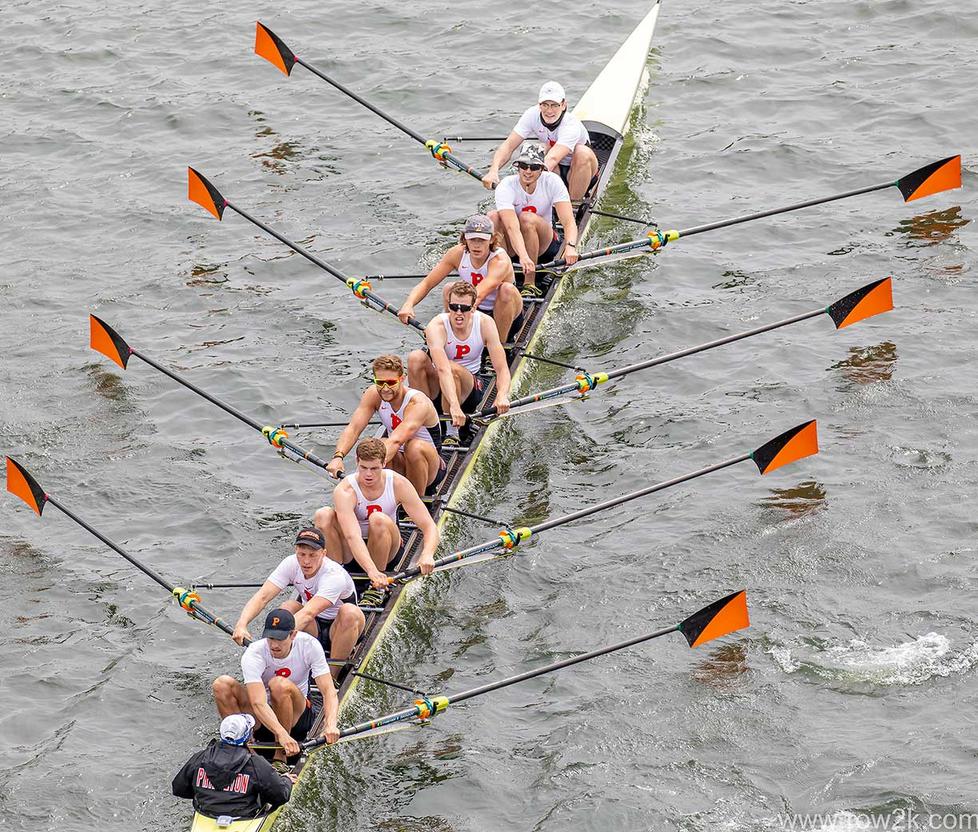Essay: A Coxswain’s View From the Boat
A race can come down to fractions of a second, and every action has a crucial impact

Julia Campbell ’22 is a coxswain with Princeton men’s heavyweight rowing. As this issue of PAW goes to press, the rowers are back in their racing shells after about a year out of the water. Toward the end of the spring semester, the University allowed sports teams to engage in local competition, and the men’s heavyweight rowers began by racing St. Joseph’s and Drexel in Philadelphia at the end of April.
As the coxswain, I sat in the stern of a 60-foot rowing shell, the only member of the crew with a forward-facing view of the course. The eight male rowers faced me. Their over-6-foot, broad-shouldered frames made for the most formidable blind spot a 5-foot, 3-inch driver could ever imagine.
Short, staccato waves slapped against the six thin boat shells lining the mouth of the lake. Lines of white buoys 2,000 meters long converged in the distance, blurry. In six minutes, a winner would emerge victorious.
I nodded at Ralph, who sat directly in front of me. He nodded back, exhaling as the official started naming the crews in the fourth-varsity Eastern Sprints Grand Final in May 2019. “Harvard, Yale, Princeton ... ” Eight black-and-orange oars submerged beneath the choppy surface of the water. “Attention ... ” Ralph raised his hands slightly, locking the blade against the tension of the water. “Go.”
And with that, the six shells launched into the unforgiving waters like bullets out of a rifle chamber. Blades shredded the lake’s surface, throwing a spray of frigid white foam into the air.
I immediately called for 20 quick strokes, nodding at Ralph to take the rate up. All eight men in the boat could hear me through their seats’ speakers, which connect to the coxswain’s headset. My numb fingers tightened around the steering cables as I tried to hold a straight line against the harsh wind and strong current.
By the 1,000-meter mark, I was sitting dead level with the Harvard and Yale coxswains. I locked eyes with the Yale coxswain for a brief moment and heard her command her crew to give 10 extra-powerful strokes. I relayed this to my crew immediately, telling them to hold them off for three strokes, then execute our own power 10. The eight guys accelerated through the end of each stroke. Harvard trailed behind us, and we jockeyed for the lead against Yale.
For the next 500 meters, it was a game of inches in a battle of wills. Then, with just 400 meters to go, we were three-quarters of a boat length down. We had never sprinted earlier than the 250-meter mark. But calling the sprint early was the only card I had left in my hand, the only possible move I could play for a chance to win. “In two, sit up and lift it to 38!” We took another two seats on Yale — moving ahead by the length of two seats in the boat — and lifted our rate again, to 40 strokes per minute.
The Yale coxswain looked back at me. She yelled something at her rowers. I continued pressing mine on, urging them to ignore the pain that had built up from lactic acid spreading throughout their muscles. It was my job to push them deeper into the pain cave, beyond what they thought their physical limits were. That was the only way we’d have a shot at reaching our shared goal: to win.
This is the thrill of the coxswain.
Just six months earlier, I had stepped into the coxswain seat of a Princeton heavyweight men’s eight for the very first time. I remember my bright orange rain boots slapping against the concrete as I ran to keep up with my long-legged teammates, carrying the daffodil-yellow boat shell from the rack to the dock. With a forced kind of confidence and in a pitch much lower and louder than my natural voice, I called for the eight guys to take the boat over their heads and into the water. I couldn’t remember the last time I’d felt this nervous. What if they didn’t like me? Would they respect a female coxswain? Would they listen to a walk-on coxswain from the suburbs of Wisconsin? What if I was just too different to fit in on the team? Thoughts like these bounced around in my head as I tested my headset microphone and prepared to launch into unfamiliar waters, with an unfamiliar crew, accompanied by unfamiliar coaches. “Fake it ’til you make it, Jules,” my mom had told me on the phone a few hours before practice, trying to ease my nerves. But there is no “faking it” in the coxswain seat.
The coxswain, as some wrongly believe, is not a small man who does nothing except say “stroke, stroke, stroke.” In fact, in the words of Seth Lesser ’83, a former men’s heavyweight coxswain, “that is the one thing we never, ever do.” Rower Jens Clausen ’21 characterizes the coxswain as simply “the brain amidst the muscle of eight rowers.” Such a role encompasses steering the boat, coaching technique, motivating the crew, managing time, handling equipment, strategizing and executing a race plan, and deviating from that plan if necessary.
Each of these duties comes with challenges of its own. Take the job of steering, for example. In theory, steering is easy. A coxswain just has to get from point A to point B in the straightest line possible. But an average eight-rower shell is more than 60 feet long, just a few feet shorter than an 18-wheel tractor-trailer. And instead of having the immediate response of a steering wheel, coxswains steer the boat’s 3-inch rudder by pushing a wire-thin cable to either side. The result is a painfully slow response time to any steering adjustments, often in tough conditions such as strong winds and currents. Finally, a coxswain must steer with the gigantic blind spot of eight heavyweight rowers sitting directly in front of her.
Micaela Keller ’20, also a former heavyweight coxswain, puts it like this: “There are a million things for a coxswain to think about in any given moment. You are the crew’s motivator, its strategist, its technical coach, its decision-maker, and its communicator. In the most high-pressure situations, you have to think about the boats around you, the technique of the guys in front of you, the amount of time that has elapsed, the number of meters remaining, the speed of the crew, the conditions of the water. And then you have to think about how to communicate that information to them at the right time and in the right way.”
A race can come down to fractions of a second, and every action has a crucial impact. The coxswain, though small in stature, has big shoes to fill.
On Lake Carnegie, our five heavyweight shells are filled with athletes from every corner of the world. There are future Olympians in these boats, and there are walk-ons who never touched a rowing oar before they arrived at Princeton. There are men, there are women. But they all come together with one purpose: to make ridiculously fast boats. Days, months, years of training pay off in a six-minute flash as our individual differences fade into the background and all that matters is how badly we want to win. In six minutes, we learn a critical lesson that many people do not learn in their entire lifetimes: We are more alike than we are different.
We lost the Eastern Sprints Grand Final to Yale by six-tenths of a second. Harvard placed third, trailing nearly 10 seconds behind us. The loss was heartbreaking.
But we learn through loss. During the COVID-19 pandemic, our team has lost a lot, as has everyone. For nearly one whole year, our team was unable to train together, race together, and be together. Finally, in February, those of us who were in Princeton were able to set foot in the boathouse once again. We are deliberate, intentional, and thoughtful with every stroke we take on Lake Carnegie not just because we want to win medals, but because we remember the time we spent apart.












2 Responses
David Myerberg ’69
4 Years AgoA Thrilling Read
Julia Campbell ’22’s essay (“A View From the Boat,” June issue) is a gripping, poignant, and informative piece on heavyweight crew, the role of the coxswain, and competitive athletics in general. I will never cross Lake Carnegie again without thinking of her description of the 2019 race where the Tigers lost by six-tenths of a second to Yale. Campbell’s short composition embodies the skill of an entertaining writer as she shines a light on the dedication, coordination, brute force, and fine tuning of the nine-person “team.” As a Division I swimmer (many moons ago) and a lifetime lover of water sports, I finally understand what a challenge and thrill it is to be a competitor in this illustrious sport. Thanks for the treat!
Rocky Semmes ’79
4 Years AgoElegant and Edifying
The exquisitely excellent essay by coxswain Julia Campbell ’22 (“A View from the Boat,” June issue) illuminated for me the intricacies and intrigue inexorably involved with rowing that no prior PAW reporting, though frequent and repeated, had ever before managed to accomplish. I am unsure if the rowers still gravitate toward the Tiger Inn, but back in the day that was where you’d find them (men then, men and women both now). Good people every one of them, but they were a difficult group to get to know as they hung together so tightly as a social group. It was kind of a rarity to (really) know any of them one-on-one if you weren’t also a rower.
But I get it now; I understand it all clearly, as Julia has explained it so elegantly and eruditely. There just wasn’t enough time in their day. These rowers are a finely-tuned machine, and the importance of synchronization in all the working parts of an engine and its transmission is critical to that engine’s power. The high-output horsepower of each rower can ill-afford any distraction from the requisite laser focus, particularly at their vaulted level of Ivy League rowing.
That latter intensity is made brilliantly clear in the exemplary headline photograph with the article. The mentally-intent gaze of each rower is locked intensely on the boat’s coxswain (Campbell), their oars parallel, perfected, and poised for power. Kudos! There is no finer reading in this world than the pages of the Princeton Alumni Weekly, it never fails to edify and please.